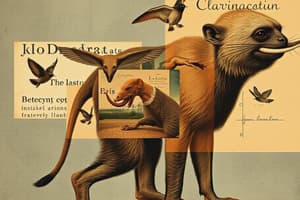Podcast
Questions and Answers
Which of the following is the correct order of classification from broadest to most specific?
Which of the following is the correct order of classification from broadest to most specific?
- Species, Genus, Family, Order, Class, Phylum, Kingdom, Domain.
- Kingdom, Domain, Class, Phylum, Order, Genus, Family, Species.
- Domain, Kingdom, Phylum, Class, Order, Family, Genus, Species. (correct)
- Phylum, Class, Order, Family, Species, Genus, Domain, Kingdom.
What does binomial nomenclature consist of?
What does binomial nomenclature consist of?
- A single name for each organism.
- A number system denoting species.
- A two-part Latin name composed of a genus and a species name. (correct)
- A list of common names for each species.
What is the primary purpose of taxonomy?
What is the primary purpose of taxonomy?
- To study ecological interactions.
- To predict animal behavior.
- To create a universal naming system for organisms. (correct)
- To develop agricultural techniques.
What is a challenge faced in taxonomy related to cryptic species?
What is a challenge faced in taxonomy related to cryptic species?
How does molecular techniques contribute to modern taxonomy?
How does molecular techniques contribute to modern taxonomy?
Which of the following modern approaches to taxonomy focuses on evolutionary relationships?
Which of the following modern approaches to taxonomy focuses on evolutionary relationships?
What does the class 'Mammalia' include?
What does the class 'Mammalia' include?
What is a significant benefit of having a standardized system of classification in biology?
What is a significant benefit of having a standardized system of classification in biology?
What does the phylum 'Chordata' refer to?
What does the phylum 'Chordata' refer to?
Which application of taxonomy focuses on biodiversity conservation?
Which application of taxonomy focuses on biodiversity conservation?
Flashcards are hidden until you start studying
Study Notes
Taxonomy and Classification in Zoology
Definition
- Taxonomy: The science of naming, describing, and classifying organisms.
- Classification: The arrangement of organisms into groups based on similarities and differences.
Hierarchical System
- Domain: Broadest category (e.g., Bacteria, Archaea, Eukarya).
- Kingdom: Second level (e.g., Animalia, Plantae).
- Phylum: Groups of related classes (e.g., Chordata for vertebrates).
- Class: Groups of related orders (e.g., Mammalia for mammals).
- Order: Groups of related families (e.g., Carnivora for carnivorous mammals).
- Family: Groups of related genera (e.g., Felidae for cats).
- Genus: Groups of related species (e.g., Panthera for big cats).
- Species: Basic unit of classification, a group of individuals capable of interbreeding (e.g., Panthera leo for lions).
Binomial Nomenclature
- Developed by Carl Linnaeus.
- Each species is assigned a two-part Latin name:
- Genus Name: Capitalized.
- Species Name: Lowercase.
- Example: Homo sapiens for humans.
Importance of Taxonomy
- Provides a universal naming system.
- Facilitates communication among scientists.
- Aids in organizing biological diversity.
- Helps in predicting characteristics based on classification.
Modern Approaches
- Phylogenetic Classification: Based on evolutionary relationships, using cladistics.
- Molecular Techniques: DNA sequencing helps refine classifications and understand evolutionary links.
- Holistic Systems: Consider ecological roles and interactions in classification.
Challenges in Taxonomy
- Cryptic species: Morphologically similar but genetically distinct species.
- Convergent evolution: Different species evolve similar traits independently.
- Taxonomic revisions: Ongoing discoveries lead to changes in classification.
Applications
- Biodiversity conservation: Identifying species helps in preserving ecosystems.
- Medicine: Understanding species relationships aids in drug discovery.
- Agriculture: Classification helps in crop improvement and pest management.
Definition
- Taxonomy: Science focused on naming, describing, and classifying organisms.
- Classification: Arrangement of organisms into groups based on similarities and differences.
Hierarchical System
- Domain: The broadest category encompassing life forms; includes Bacteria, Archaea, and Eukarya.
- Kingdom: The second level of classification, such as Animalia (animals) and Plantae (plants).
- Phylum: Groups organisms into related classes; for instance, Chordata includes all vertebrates.
- Class: Organizes related orders; an example is Mammalia, which encompasses all mammals.
- Order: Groups related families; Carnivora includes carnivorous mammals.
- Family: Contains related genera; Felidae refers to the family of cats.
- Genus: A group of closely related species; example includes Panthera, which covers big cats.
- Species: The most specific classification unit, comprising individuals capable of interbreeding, such as Panthera leo for lions.
Binomial Nomenclature
- Developed by Carl Linnaeus to standardize species naming.
- Species are given a two-part Latin name:
- Genus Name: Always capitalized.
- Species Name: Always in lowercase.
- Example: Homo sapiens represents humans.
Importance of Taxonomy
- Establishes a universal naming system, enhancing clarity in biology.
- Aids scientists in communication regarding diverse organisms.
- Organizes biological diversity, making it easier to study life forms.
- Enables predictions about characteristics based on taxonomic relationships.
Modern Approaches
- Phylogenetic Classification: Based on evolutionary history using cladistics.
- Molecular Techniques: DNA sequencing techniques improve classification reliability and clarify evolutionary connections.
- Holistic Systems: Includes ecological roles and interactions in the classification of organisms.
Challenges in Taxonomy
- Cryptic Species: Species that appear morphologically identical but are genetically distinct.
- Convergent Evolution: Different species evolving similar traits independently due to similar environmental pressures.
- Taxonomic Revisions: Ongoing changes in classification as new discoveries are made.
Applications
- Biodiversity Conservation: Understanding species helps in the preservation of ecosystems.
- Medicine: Knowledge of species relationships aids drug discovery processes.
- Agriculture: Classification systems assist in crop improvement and pest management strategies.
Studying That Suits You
Use AI to generate personalized quizzes and flashcards to suit your learning preferences.




